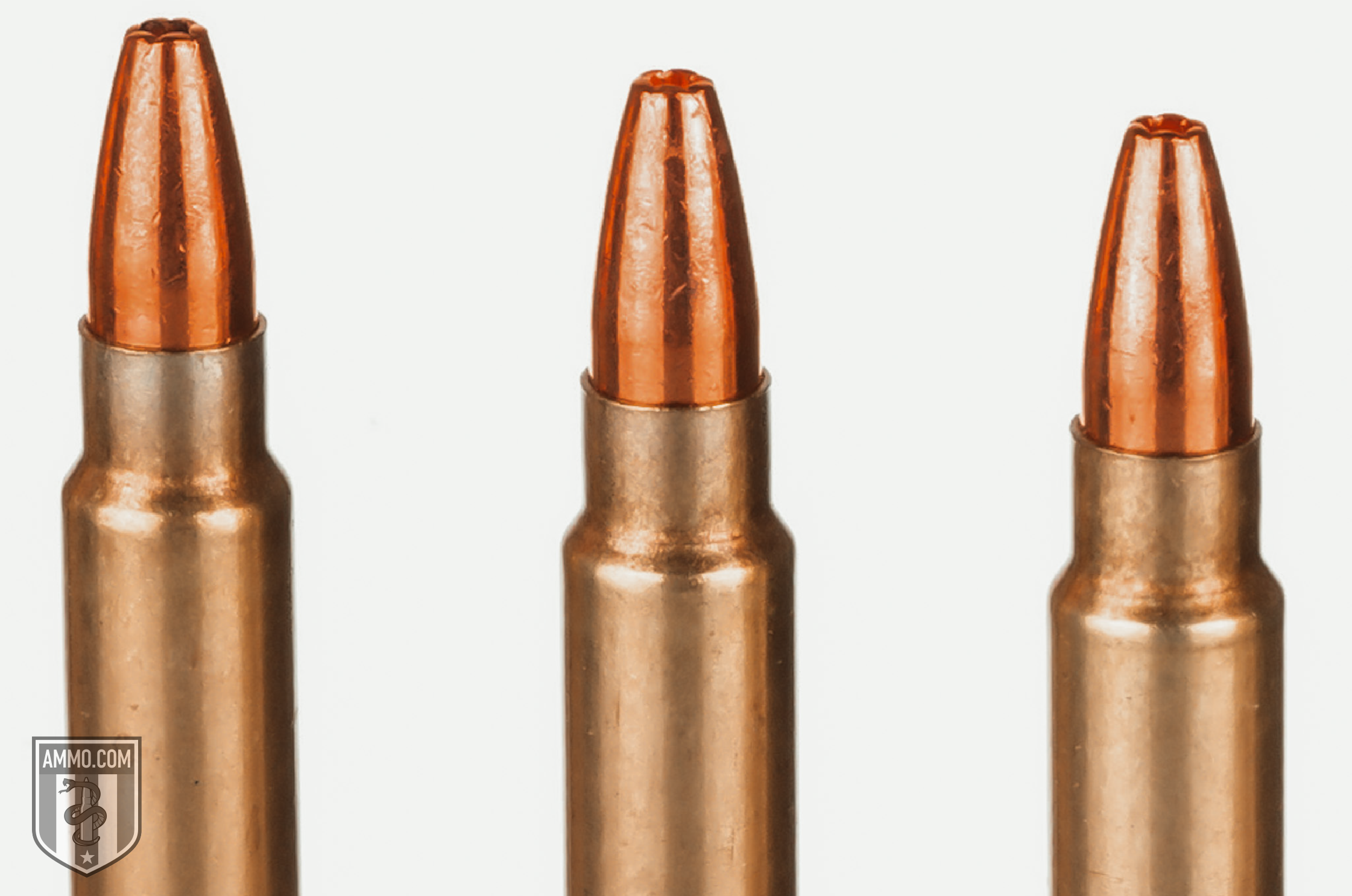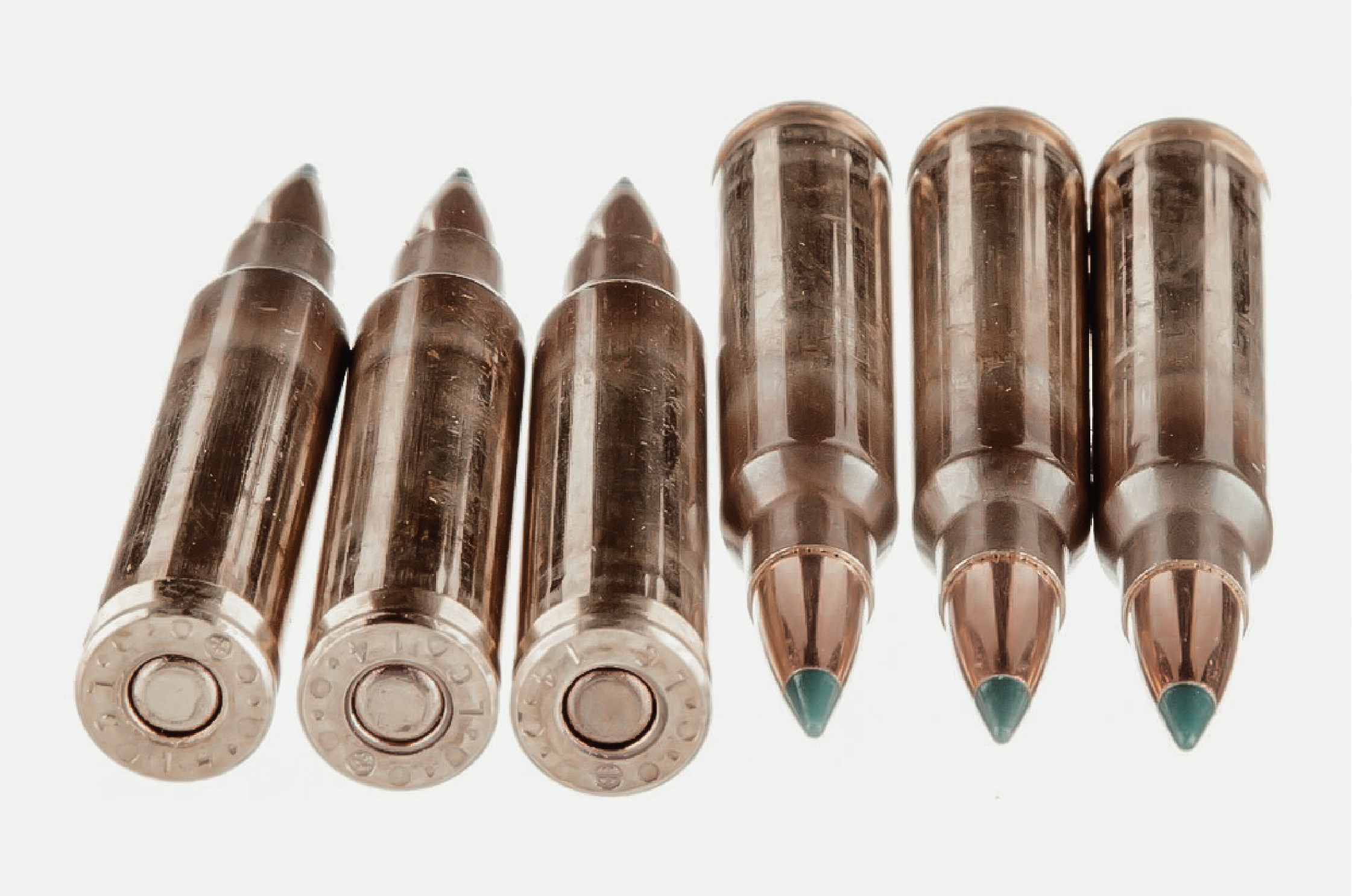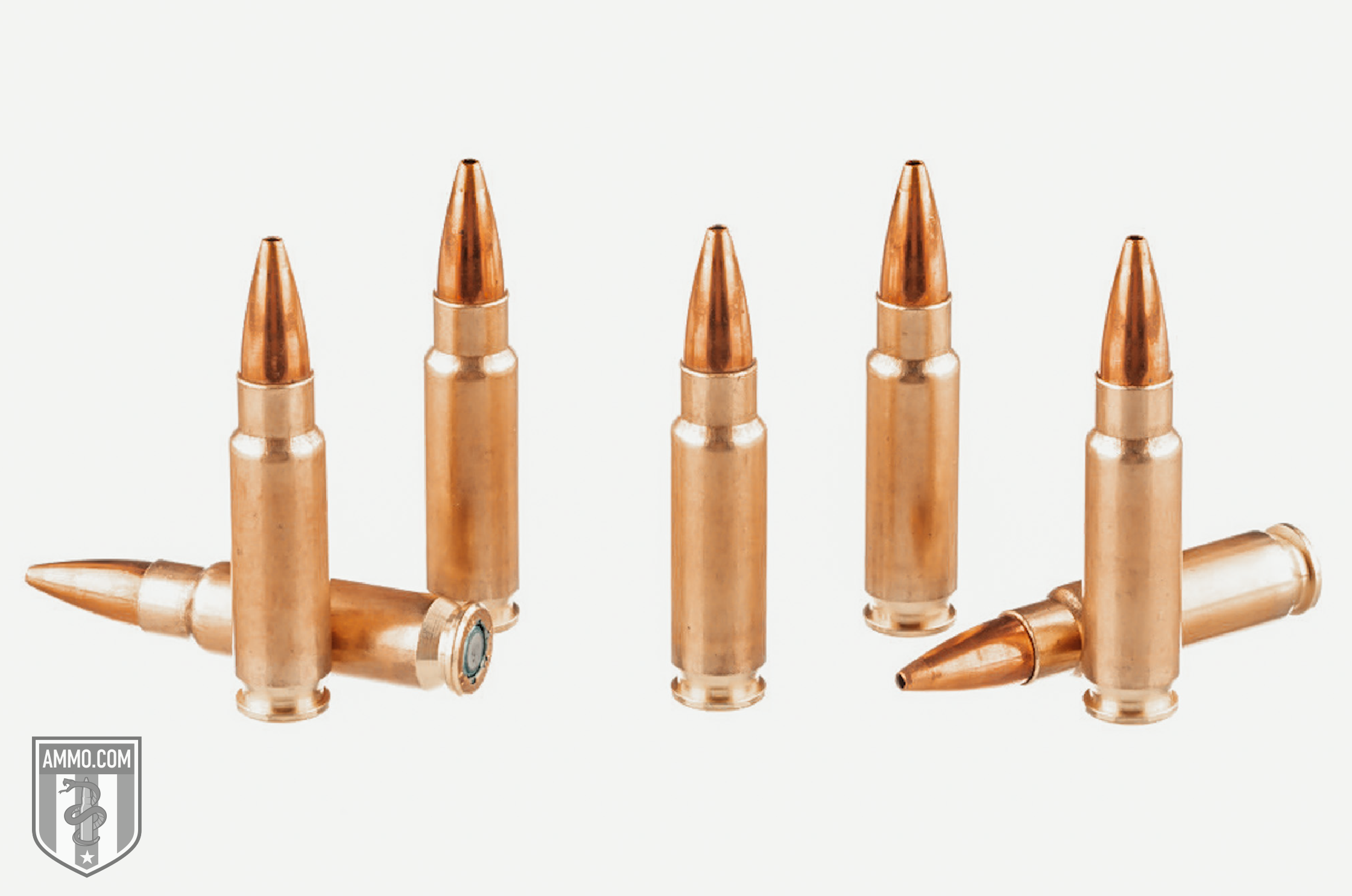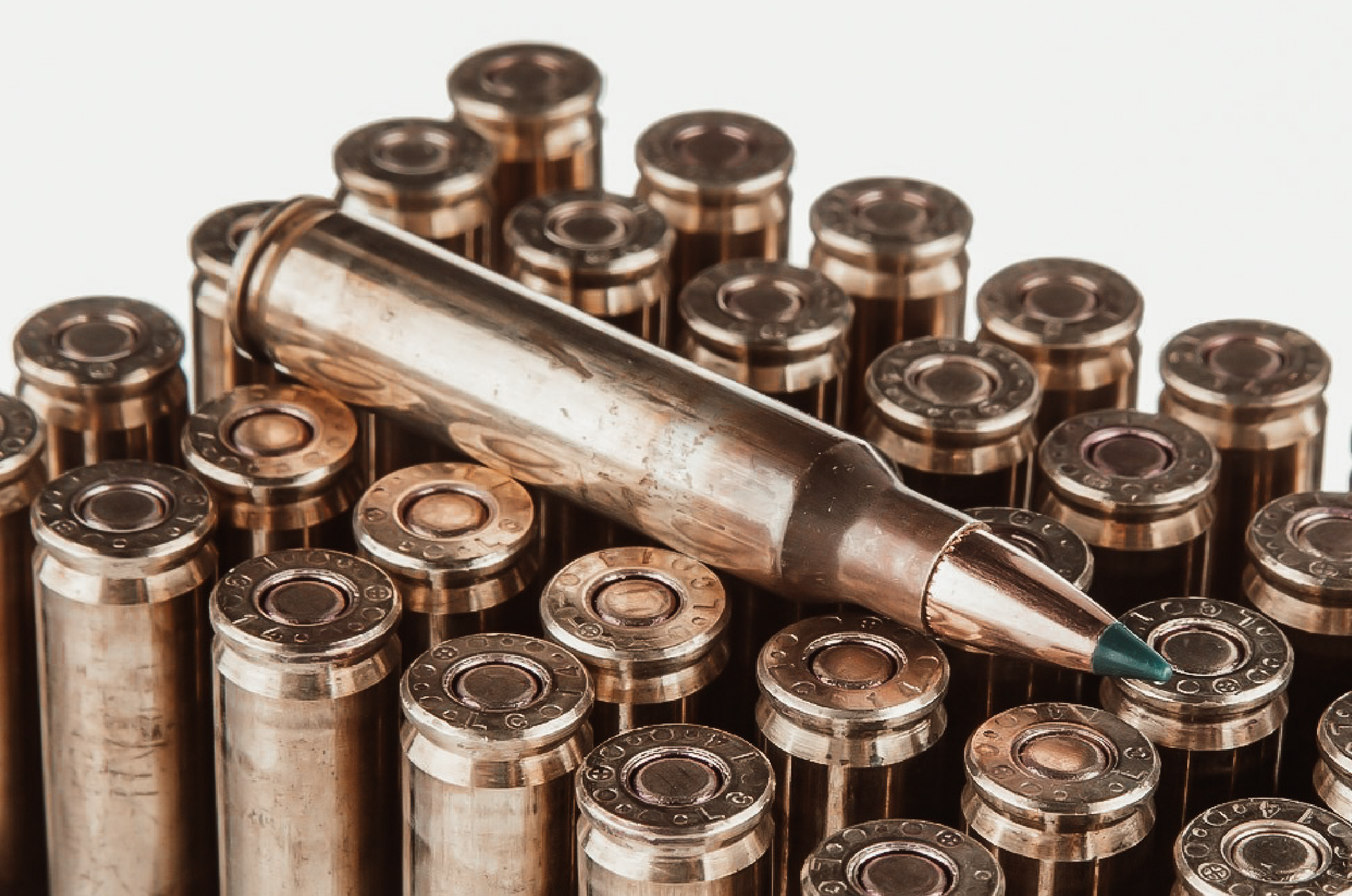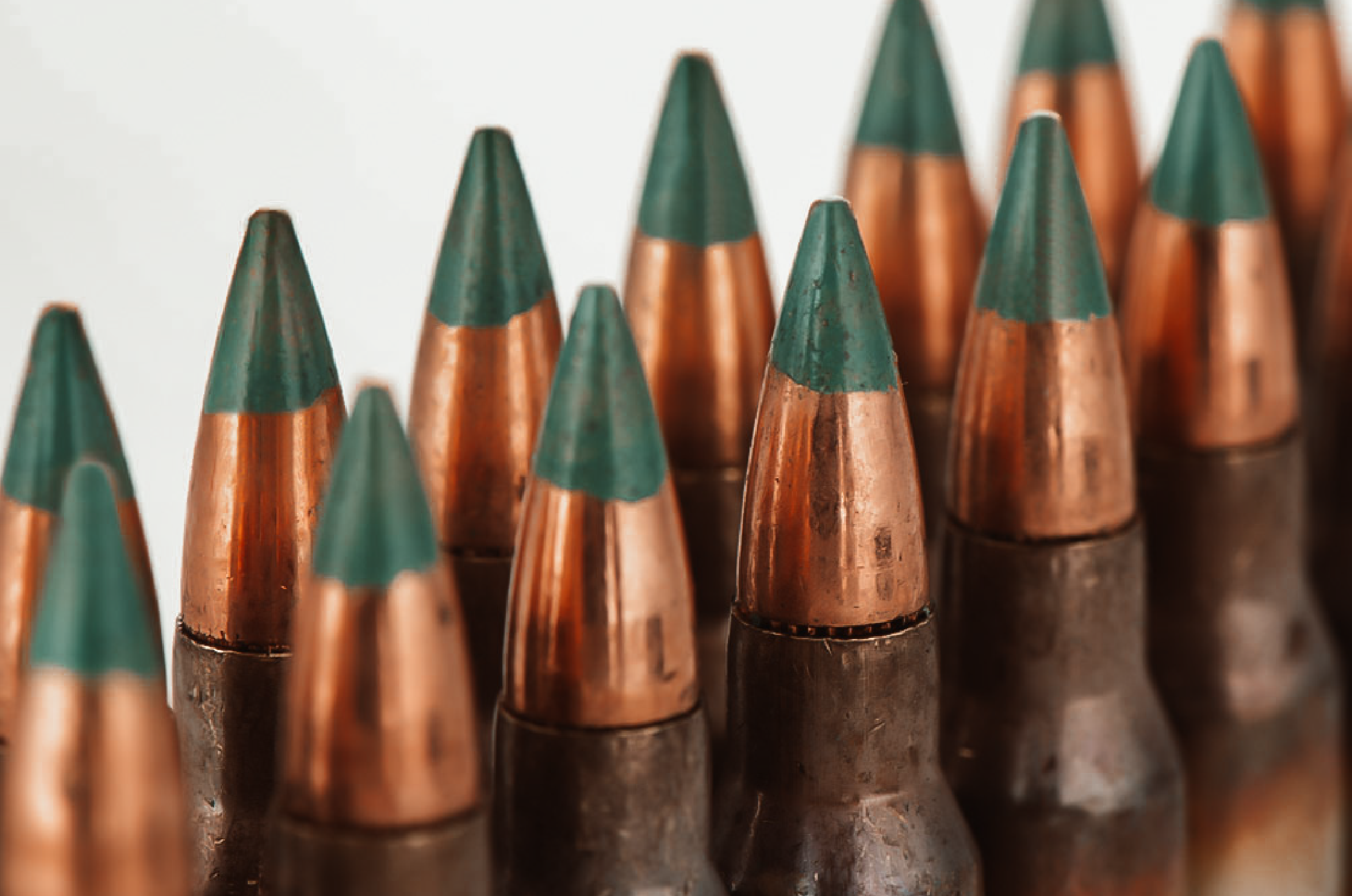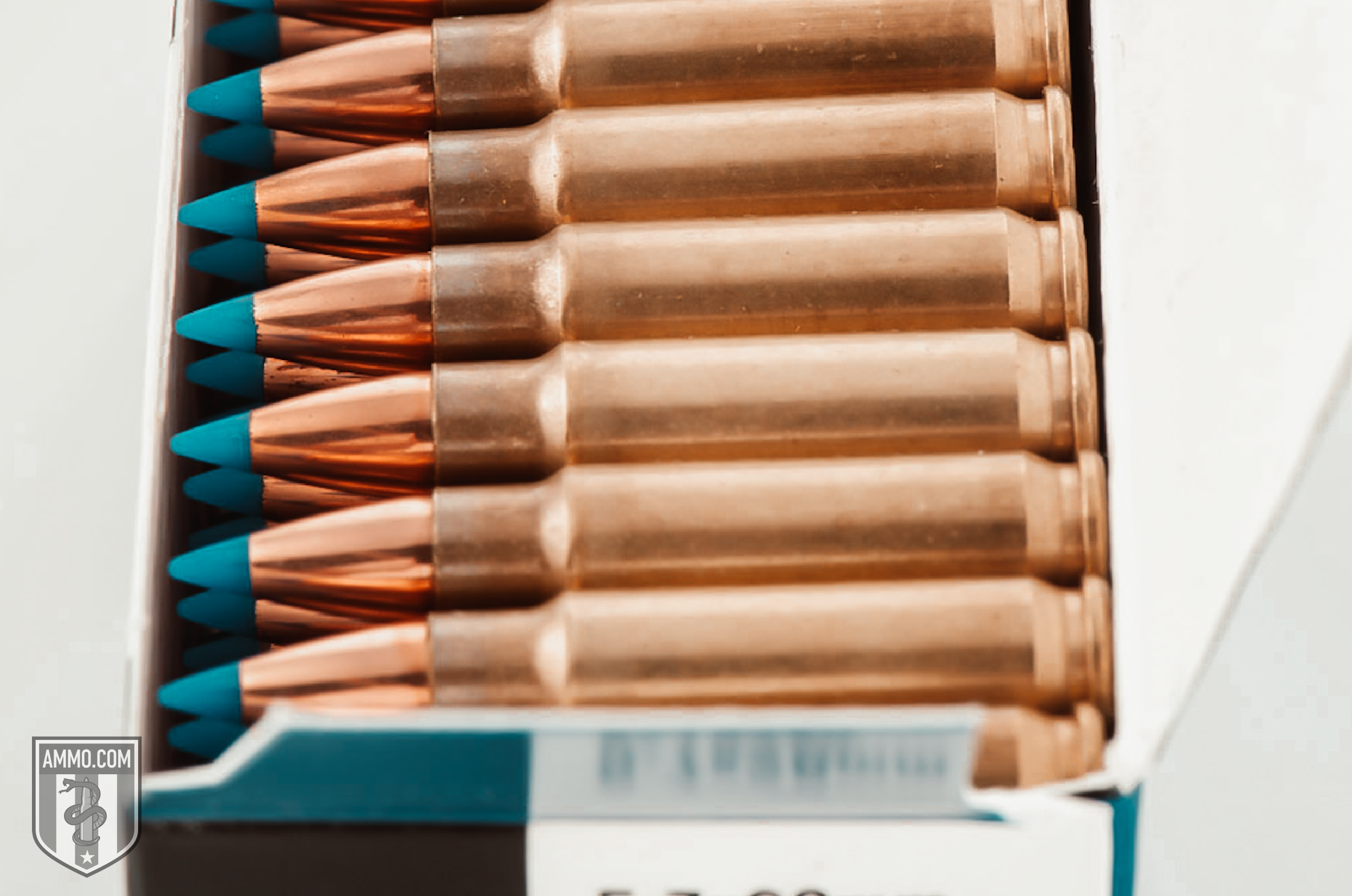5.56 vs 5.7: Can a Pistol Caliber Compete with a Rifle?
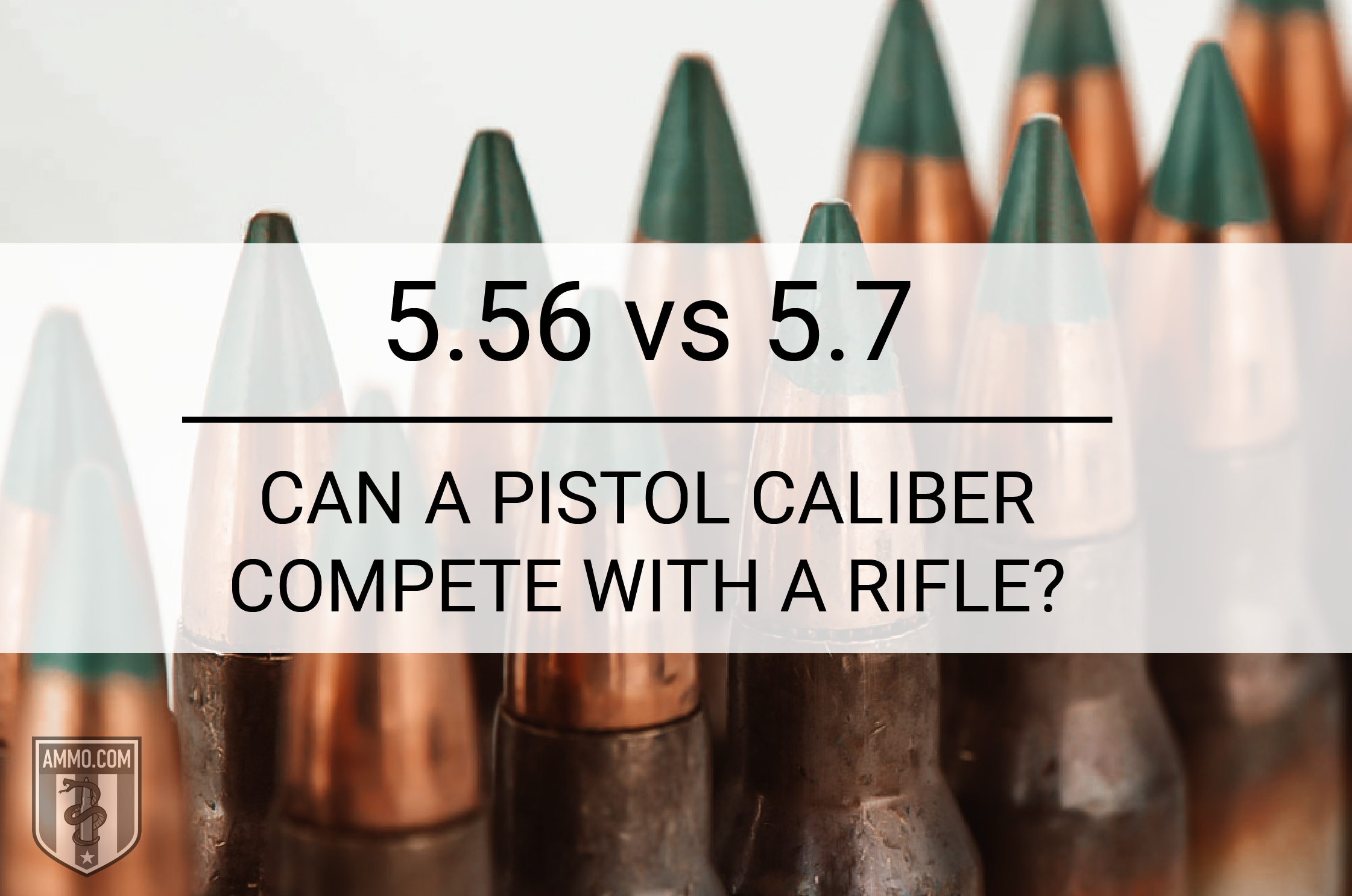 Judging by the popularity of the rounds in the US today, the 5.56 doesn't seem to have many worthy competitors. However, some believe the 5.7mm is a worthy opponent despite these cartridges being created for different purposes.
Judging by the popularity of the rounds in the US today, the 5.56 doesn't seem to have many worthy competitors. However, some believe the 5.7mm is a worthy opponent despite these cartridges being created for different purposes.
When we compared the 5.56 vs 5.7, it was clear that each has its purpose, but one round has more advantages than the other. The 5.56 can be used in a wider variety of scenarios. Therefore, we chose the 5.56 as the superior round, but only slightly.
5.7 Vs. 5.56: What's The Difference?
Though at first glance, one might think these rounds are similar with only minute differences, that would be an incorrect assumption. The 5.56x45 was designed as a rifle cartridge, whereas the 5.7x28 was designed as a pistol cartridge.
The 5.7 looks like a hybrid between the 5.56 and the .22lr. That's also how many people classify the 5.7 in terms of its usefulness. It's similar to the .22 magnum.
So, in theory, the 5.56 should easily be the superior round. However, the 5.7 has its advantages in distinct situations.
Cartridge Specs
The bullet diameter of each round is the same at .224". Because the 5.56x45 was designed as a rifle round, it is a larger cartridge. Both rounds use a centerfire cartridge. The overall length of the 5.56 is 2.26" whereas the overall length of the 5.7 is only 1.594". The case length of the 5.7 is 1.138" which is half an inch shorter than the 1.76" of the 5.56 case.
The shorter case length translates into less capacity. The case capacity for the 5.7 is 13.9gr, while the 5.56 case capacity is 28.5gr.
If you're looking for a more powerful round, the 5.56 is easily the more powerful ammo. However, if you're looking for a compact round the 5.7 is the way to go.
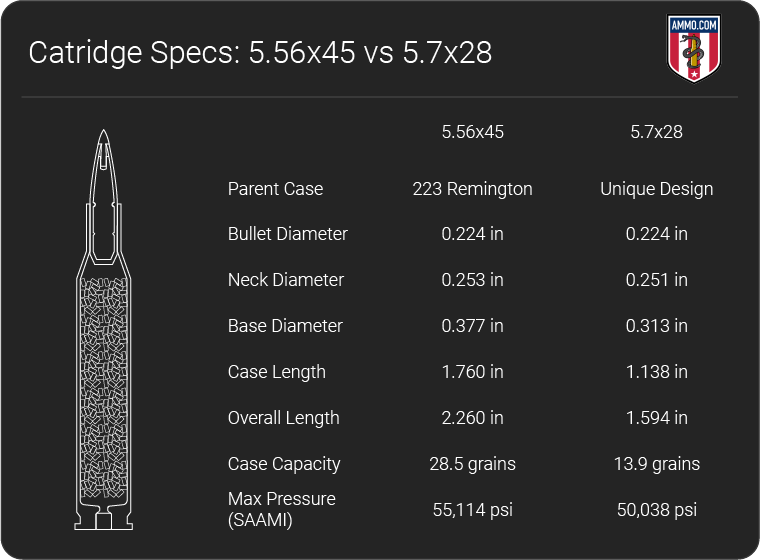
Recoil
I took my wife and mother-in-law shooting for the first time several years ago. Neither had much experience with firearms, especially 5.56 rounds. Both were surprised by how little my AR recoiled. Despite what politicians might want you to believe, 5.56 and .223 caliber guns don't kick much at all.
The 5.56 NATO has 5 ft-lbs of felt recoil when using a 7lb gun. That's minuscule compared to a 30-06, which has 25 ft-lbs! That's one reason why hunters are switching the 5.56 if they can.
The felt recoil of the 5.7 in a 1.6lb handgun is 1.7 ft-lbs. If we fire the same round from an AR platform firearm, the recoil will barely be noticeable. Even though it's a larger round than a .22lr, the recoil is very comparable.
While the 5.56 has little recoil, the 5.7 has much less recoil. So if you're making your judgment solely based on recoil, the 5.7 is the round for you.
Trajectory
The trajectory is the flight path the bullet takes to the target. It's measured in bullet drop. The flatter the trajectory, the better because it requires fewer adjustments when shooting targets at different distances.
The 5.56 NATO round was designed for long-range and short-range shooting. The U.S. military uses lightweight, high-velocity 55gr and 62gr bullets to achieve a flat shooting round. The 5.56 NATO 62-grain bullet drops roughly 23" at 400 yards. This might seem like a lot, but common rounds like the 7.62x39 have nearly double the bullet drop at that distance.
The 5.7 doesn't drop below the point of aim until 165 yards. Since it is a pistol caliber, it's not designed for long-distance shooting, so its effective range is around 250 yards with 11" of bullet drop.
The 5.56 Nato has a much better trajectory for extended range shooting than the 5.7. However, out to 150 yards, they have a similar path.
Accuracy
The accuracy of a round will be determined by several factors, including the gun, barrel length, shooter's skill level, and bullet type. Rifles are generally more accurate than pistols, so for this comparison, we will only be speaking of accuracy when both rounds are fired from a rifle.
When firing from the AR platform, these calibers offer similar accuracy to about 150 yards. Any further than that, the 5.56 rounds outperform the 5.7 rounds. The 5.7 doesn't have enough power to maintain its accuracy at further distances.
The 5.56 easily wins the accuracy category at longer ranges. If you plan to use your firearm closer than 150 yards, the 5.7 is still a viable option because both calibers are so similar.
Ballistic Coefficient
The ballistic coefficient (BC) is a measurement of how well the bullet resists wind and air resistance. In English, it's how aerodynamic the bullet is. The higher the BC, the better because it resists wind drift better.
Typically, heavier bullets have a higher ballistic coefficient. There are rare instances when the smaller, more aerodynamic bullet has a higher BC. Obviously, the ballistic coefficient will vary from bullet to bullet, but on average, a 5.56 bullet has a BC of 0.29, and the 5.7 has an average BC of 0.197.
As we expected, the 5.56 NATO continues to outperform the 5.7.
Stopping Power
Stopping power can be measured in Sectional Density (SD) which is how well a bullet penetrates a target. Sectional density is the bullet weight compared with the bullet diameter. The larger the number, the better it will penetrate a target.
The stopping power of the 5.56 is greater than the 5.7 because the 5.56 is a more powerful round with a heavier projectile. The 5.7 does have an armor-piercing round, but it's only available to military and law enforcement.
Different bullet styles also have differing amounts of stopping power. For example, expanding bullets will cause more damage than a full metal jacket (FMJ) because of the fragmentation of the expanding bullets.
For the average civilian, the 5.56 Nato will have more stopping power than a 5.7x28.
Hunting
Neither round is suitable for big game hunting. The bullets are not large enough to ethically take down a large animal. The 5.56mm can be used to hunt deer in some states. However, there are much better options to make an ethical shot. Such as the 300 Blackout.
Close-range predator and small game hunting can be done with either caliber, but as the distances increase, the 5.56x45mm begins to outshine the 5.7x28. Hunting small game like rabbits and squirrels with a 5.56 caliber is a little overkill, but you won't waste any meat with a well-placed shot.
I recommend the 5.56 NATO over the 5.7 at all distances for all medium and most small game hunting.
Self-Defense/Home Defense
I prefer to use a 12 gauge or 20 gauge for self-defense and home protection because buckshot is less likely to penetrate walls and strike an innocent bystander. Rifle bullets will penetrate sheetrock and thin metal, so you must be more accurate and confident with your shot placement. That's not as easy as it sounds in an intense situation.
I do recognize there are benefits to using 5.56 or 5.7 for home defense purposes. The first is capacity. 30 and 40 round magazines are standard in the AR platform. So if you're forced to defend yourself, you should have plenty of ammo in the magazine.
Another reason I can't argue against using a 5.56 as a home-defense weapon is that the military and law enforcement use it to protect themselves and others. If the 5.56x45 is good enough for the military and law enforcement, it's good enough for me. Just remember they regularly train with their firearms, and we should too.
Lastly, it's easier to be more accurate with a rifle than with a pistol. The rifle's longer barrel enables more people to be more accurate with a rifle than a pistol generally.
The 5.7x28 holds more rounds in a more compact magazine, while the 5.56 has more knockdown power. The 5.7 is also a pistol round, so you can use it in your concealed carry pistol and protect your home.
This debate is similar to the 9mm vs. 45 ACP debate, so I don't plan on ending it with this article, but if it was me and I had to choose between the 5.7 vs. the 5.56, I would stick with a 5.56 for home defense.
Ammo And Rifle Cost And Availability
Firearm and ammo availability and costs are significant factors many overlook when first purchasing a firearm. In recent years ammo has drastically increased in price and become more scarce. That's why it's essential to buy your new gun in a caliber that most ammo companies are manufacturing.
The 5.56 NATO is a widespread round used by military, law enforcement, and civilians. Most sporting goods and gun stores will have a supply of 5.56 or .223, and if they don't, they have some on order arriving ASAP.
The 5.7x28, on the other hand, is not a typical round found in sporting goods and gun stores. We carry it at ammo.com; you can find it here when it's in stock. Despite being a smaller round, 5.7 ammo is more expensive than 5.56 ammo.
So if you enjoy punching holes in paper for fun, the 5.56 is already looking like the better option!
Gun prices are constantly changing, but as of this writing, you can pick up a decent 5.56 AR-15 for $800 - $1,200. The starting price for a 5.7 pistol like the Ruger 57 is $900 or $1,200 for an AR. If you already own an AR-15, you can purchase a separate 5.7 AR upper, which will reduce the price.
Some guns chambered in 5.7 like the FN P90 are classified as a Personal Defense Weapon (PDW) that can only be purchased by the military or law enforcement because of ATF restrictions.
If you're only purchasing a firearm based on price and availability, choose the 5.56. It's common ammunition at a reasonable price.
Don't miss out on our exclusive deals - check out our Winchester 5.56 ammo page today!
Buying in bulk is always smart, make sure to check out our stock of 5.56 bulk ammo.
Reloading
Reloading gives you extreme control over the production of your ammo. You can tailor your rounds to get the most outstanding performance from your firearm. So if you enjoy getting the most out of your equipment, then reloading is an excellent hobby to pick up. It's also typically less expensive and more accurate than buying factory ammunition.
Because the 5.56 NATO is a round commonly shot by firearms enthusiasts, there are plenty of reloading options for this caliber. Reloading is cheaper than buying factory ammo for 5.56. Sometimes confusing to new reloaders, there are no exclusive 5.56 NATO dies. A 5.56 specific reloading die is unnecessary since the case dimensions for .223 Rem and 5.56 NATO are the same.
Reloading the 5.7 is becoming more popular amongst shooters. It's cheaper than buying factory rounds, and reloading information is updated regularly for the 5.7x28.
As with all reloading, you must pay attention to the details and follow the manufacturer's recommendations instead of a faceless name on the internet.
A lot of people love to reload the 5.56. The supplies are easier to find and purchase, and there's more trustworthy information on the 5.56 caliber.
5.56x45 Ballistics Chart
Note: This information comes from the manufacturer and is for informational purposes only. The actual ballistics obtained with your firearm can vary considerably from the advertised ballistics. Also, ballistics can vary from lot to lot with the same brand and type load.
| 5.56x45mm Bullet WEIGHT | Muzzle VELOCITY (fps) | Muzzle ENERGY (ft. lbs.) | TRAJECTORY (in.) | |||||||||||
|---|---|---|---|---|---|---|---|---|---|---|---|---|---|---|
| Muzzle | 100 yds. | 200 yds. | 300 yds. | 400 yds. | Muzzle | 100 yds. | 200 yds. | 300 yds. | 400 yds. | 100 yds. | 200 yds. | 300 yds. | 400 yds. | |
| 55 Grain NATO | 3130 | 2740 | 2382 | 2051 | 1750 | 1196 | 917 | 693 | 514 | 372 | 1.1 | 0 | -7.3 | -23 |
| 75 Grain NATO | 2910 | 2676 | 2543 | 2242 | 2041 | 1410 | 1192 | 1002 | 837 | 693 | 1.2 | 0 | -7 | -21 |
5.56 Development
The 5.56x45mm was developed by Eugene Stoner for the military in the late 1950s. The Military has strict requirements for this new round, including
- Maintain supersonic speeds above 1,080 feet per second (fps) at 500 yards
- Penetrate an Army-issued steel helmet at 500 yards
- Penetrate a .135-inch steel plate at 500 yards
- Reach the ballistic performance and accuracy of M2 ball ammunition, the military version of the .30-06 Springfield
- Wound as efficiently as the M1 Carbine, which fired .30 Carbine cartridges
By the early 1960s, the U.S. Air Force ordered 80,000 AR-15 rifles chambered in 5.56. The U.S. Army shortly followed suit by officially adopting the 5.56 M16 ( The full-auto version of the civilian AR-15). After the Vietnam War, the round became popular internationally and in the United States.
As they say, the rest is history! If you'd like more details, check out the post I condensed that's halfway down our 5.56x45mm ammo page.
5.7 Development
In 1991, NATO asked FN Herstal (FNH) for a replacement for the 9x19mm because kevlar was effective at stopping that round. The small-caliber 5.7x28 was the product of the limited requirements.
The 5.7 is compact and will penetrate a level IIIA body armor vest at 219 yards. The shape of the bullet reduces the chance of ricocheting, which decreases the risk of collateral damage and makes it a viable personal defense weapon. Since the 5.7 weighs half as much as a 9mm, soldiers can carry twice the amount of ammo.
This is why it's becoming an increasingly popular weapon system with international militaries and some US agencies. If you want to dive deeper into this subject, check out this post on the history of the 5.7x28.
5.7 vs 5.56: Final Round
Comparing the 5.56 vs. 5.7 is not equal. While both were created for combat purposes, these cartridges are very different. The 5.56x45 was intended to be shot from rifles. It's a longer, more powerful cartridge that excels at short and long-range shooting. The 5.7mm rounds were designed to be fired from an FN five-seven pistol and excel at close-range shooting.
If I were forced to choose only one, I would purchase the 5.56 because of its expanded range compared to the shorter range of the 5.7 round.
Ammo Comparisons
- .308 vs 5.56
- 6.5 Creedmoor vs .308
- .300 Blackout vs .308
- .300 Win Mag vs .308
- .243 vs .308
- .308 vs .30-06
- 7mm-08 vs .308
- .270 vs .308
- 7.62x39 vs .308
- .223 vs .308
- .338 Lapua vs .308
- .380 ACP vs 9mm
- .223 vs 5.56
- .300 Blackout vs 5.56
- 9mm vs 45 ACP
- 9mm vs 40 S&W
- .357 SIG vs 9mm
- 10mm vs 9mm
- 9mm vs 9mm Luger
- .243 vs .270
- .300 Win Mag vs .30-06
- .270 vs .30-06
- .40 vs .45
- 38 Special vs 357
- 9mm vs 40 vs 45
- 5.56 vs 7.62x39
- 338 Lapua vs .30-06
- .30-30 vs .30-06
- 300 PRC vs 338 Lapua
- .30-06 vs 7mm
- 300 Win Mag vs 338 Lapua
- 300 PRC vs 300 Win Mag
- 300 WSM vs 300 Win Mag
- 338 Win Mag vs 338 Lapua
- 12 Gauge vs 20 Gauge
- 10mm vs 357 Mag
- .30-30 vs 7.62x39
- 224 Valkyrie vs 22-250
- 17 HMR vs 22 Mag
- 7.62x39 vs .300 Blackout
- 45 ACP vs 45 Auto
- 45-70 vs 30-30
- 300 Blackout vs 223
- 357 Magnum vs 9mm
- 350 Legend vs 300 Blackout
- 224 Valkyrie vs 223
- 45 ACP vs 38 Super
- 6.5 Grendel vs .308
- 17 HMR vs 22 LR
- 10 Gauge vs 12 Gauge
- 22-250 vs 223
- 45 Colt vs 45 ACP
- 350 Legend vs 30-30
- 5.7x28 vs 223
- 5.7 vs 9mm
- 5.56 vs 5.7
- 22 vs 9mm
- Buckshot vs Birdshot
- 450 Bushmaster vs 308
- 450 Bushmaster vs 223
- Buckshot vs Slug
- 6.5 Grendel vs 5.56 vs 223
- 6mm ARC vs 6.5 Grendel
- 44 vs 45
- 458 SOCOM vs 5.56
- 357 vs 44
- 32 ACP vs 380
- 300 Win Mag vs 338 Win Mag vs 338 Lapua Mag
- 450 Bushmaster vs 458 SOCOM vs 50 Beowulf
- 6mm Creedmoor vs 6.5 Creedmoor
- TMJ vs FMJ
- 44 Special Vs 44 Magnum
- 45 90 vs 45 70
- 6.8 Western vs 6.8 SPC
- 50 Beowulf vs 50 BMG
- 26 Nosler vs 6.5 PRC
- 28 Gauge vs 410
- 6.8 SPC vs 5.56
- 6.8 SPC vs 6.5 Grendel
- 6.8 Western vs 7mm Rem Mag vs .28 Nosler
- 6.8 Western vs 6.5 Creedmoor
- 22 Hornet vs 223
- 6.8 Western vs 6.5 PRC
- .410 vs 12 Gauge
- .410 vs 20 Gauge
- 22 LR vs 22 Mag
- 6mm ARC vs 243
- 7mm-08 vs 270
- 243 vs 6.5 Creedmoor
- Nickel vs Brass Casing
- 204 Ruger vs 223
- 50 Beowulf vs 5.56
- 260 Remington vs 6.5 Creedmoor
- 6mm Remington vs 243
- 28 Nosler vs 300 PRC
- 50 Beowulf vs 50 AE
- 22 Nosler vs 22-250
- 450 Marlin vs 45-70
- 300 Win Mag vs 300 Norma
- 458 SOCOM vs 300 Blackout
- 38-55 vs 45-70
- 22 Hornet vs 22 LR
- 300 Norma vs 338 Lapua
- 338 Lapua vs 50 BMG
- 28 Nosler vs 300 Win Mag
- 28 Nosler vs 6.5 Creedmoor
- 204 vs 22-250
- 458 SOCOM vs 45 70
- 44 40 vs 45 70
- 6.8 SPC vs 6.5 Creedmoor
- 450 Bushmaster vs 30-06
- 7mm Rem Mag vs 300 Win Mag
- 30 Carbine vs 223
- 25-06 vs 30-06
- 26 Nosler vs 28 Nosler
- 16ga vs 12ga
- 30 06 vs 7.62 x54R
- 9mm Makarov vs 9mm Luger
- 350 Legend vs 223
- 30 Carbine vs 5.56
- 6.5x55 vs 6.5 Creedmoor
- 6.5 Creedmoor vs 270 vs 25-06
- M193 vs M855
- 450 Bushmaster vs 458 SOCOM
- 6.5 Grendel vs 6.5 Creedmoor
- 350 Legend vs 5.56
- .277 Fury vs 6.8 SPC
- 277 Fury vs 300 Win Mag
- 10mm vs .45 ACP
- 277 Fury vs 223
- 6.8 SPC vs 300 Blackout
- 6.5 PRC vs 6.5 Creedmoor
- 277 Fury vs 308
- 277 Fury vs 6.5 Creedmoor
- 350 Legend vs 450 Bushmaster
- 277 Fury Vs 5.56 NATO
- 10mm vs 40S&W
- 32 ACP vs 9mm
- 32 Special vs 9mm
- 8.6 Blackout vs 300 Blackout
- 30 Super Carry vs. 9mm
- 5.56 vs 9mm
- .50 Action Express vs 9mm
- 7.62x25 vs. 9mm
- 10mm vs 44 Magnum
- 300 Blackout vs 300 Win Mag
- 6.5 Grendel vs 300 Blackout
- 460 Rowland vs 10mm
- 300 RUM vs 300 PRC
- 300 Norma vs 300 PRC
- 45 GAP vs 45 ACP
- 7mm PRC vs 300 Win Mag
- 300 PRC vs 6.5 Creedmoor
- 300 PRC vs 308
- 357 SIG vs 357 Mag
- 7.62x39 vs 7.62x51
- 243 Win vs 223 Rem
- 30 Nosler vs 300 PRC
- 6.5 Creedmoor vs. 30-06 Springfield
- 450 S&W vs. 44 Magnum
- 6.5 Creedmoor vs. 300 Win Mag
- 454 Cassull vs. 45-70 Govt
- 454 Cassull vs. 44 Mag
- 7.62x54r vs. 308 Winchester
- 22 ARC vs. 223 Rem
- Subsonic vs. Supersonic Ammo
